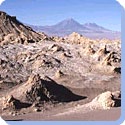 Many deserts-places, which have less than 25cm (10in) rainfall a year-are, in fact, dry for years and then a freak storm causes floods. Or heavy rains can transform some deserts, as in Namaqualand, South Africa, into a sea of flowers, bringing new life to seeds, which may have been dormant for years. Elsewhere, drought-resistant plants like cacti soak up rainwater in their swollen stems. Such events are, however, unknown in Chile’s Atacama Desert. This is the world’s desert place where no rain has fallen in 400 years!
Many deserts-places, which have less than 25cm (10in) rainfall a year-are, in fact, dry for years and then a freak storm causes floods. Or heavy rains can transform some deserts, as in Namaqualand, South Africa, into a sea of flowers, bringing new life to seeds, which may have been dormant for years. Elsewhere, drought-resistant plants like cacti soak up rainwater in their swollen stems. Such events are, however, unknown in Chile’s Atacama Desert. This is the world’s desert place where no rain has fallen in 400 years!
The world’s largest desert, the Sahara, covers about 8,400,000 square km (3,250,000 square miles). It is a hot desert, though it may be freezing cold at night because there are no clouds to stop heat escaping into space. In Antarctica, Greenland and the northern USSR there are cold deserts, where the annual rainfall (or the equivalent in snow) is as low as in a hot desert. Here, the snow blown into year face during blizzards isn’t usually falling from above-it is simply loose snow swept up from the surface of the ground.
 Kids Portal For Parents India Kids Network
Kids Portal For Parents India Kids Network






